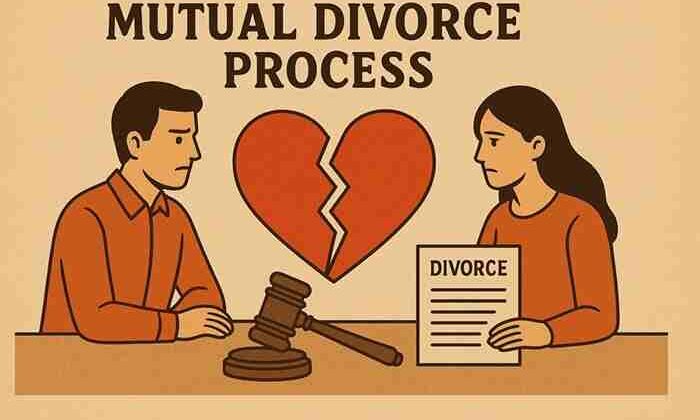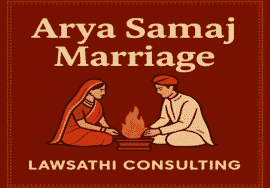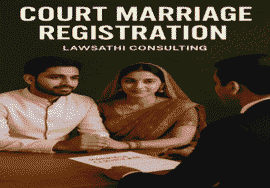
Mutual Consent Divorce: Lawyers & Legal Help – Lawsathi Lawyer
Introduction
Marriage represents companionship, but when differences become irreconcilable, separation with dignity becomes the only option. The Hindu Marriage Act, 1955, under Section 13B, permits couples to mutually and peacefully end their marriage. A Mutual Consent Divorce is the most respectful, time-saving, and straightforward method to dissolve a marriage in India. Mutual Consent Divorce Lawyers.
At Lawsathi Lawyer, we help couples through the entire process — from document preparation to court representation — ensuring the procedure remains smooth and stress-free.
⚖️ What Is a Mutual Consent Divorce?
Mutual Divorce is a legal process where both spouses agree to end their marriage amicably. They jointly file a petition in court, stating that they have been living separately for a required period and have mutually agreed that they cannot live together.
Under Section 13B of the Hindu Marriage Act, 1955, mutual divorce requires two motions — one for filing and another for confirmation after a six-month waiting period. This period allows time for reconciliation, ensuring the decision is made with a calm mind.
🧭 Complete Procedure of Mutual Consent Divorce
Understanding the legal process helps avoid confusion and ensures faster results. Here’s a step-by-step guide to how mutual divorce works in India: Mutual Consent Divorce Lawyers.
Step 1: Consultation with a Family Lawyer
Before filing, both parties should meet an experienced divorce lawyer to understand their rights, discuss terms of separation, and draft an agreement covering alimony, child custody, and property division.
Step 2: Filing the Joint Petition
A joint petition is filed before the Family Court where: Mutual Consent Divorce Lawyers.
The marriage took place, or
The couple last resided together, or
Either spouse currently resides.
The petition includes details of marriage, reasons for separation, and a mutual agreement to dissolve the marriage.
Step 3: First Motion Hearing
Both parties must appear before the court to record their statements. The judge ensures that the consent is genuine, voluntary, and free from pressure.
Step 4: Cooling-Off Period
After the first motion, the law provides a six-month “cooling-off period” for possible reconciliation. However, if both parties remain firm in their decision, Court can allows this period to be waived through an application citing mutual agreement and absence of scope for reunion.
Step 5: Second Motion and Final Hearing
After six months (or earlier, if waived), both parties appear again for the second motion. The court verifies that consent still exists and then passes the final decree of divorce.
Step 6: Divorce Decree
Once satisfied, the judge grants a Decree of Divorce officially dissolving the marriage. Both parties receive certified copies of the decree for legal records.
📑 Documents Required for Mutual Consent Divorce
Proper documentation ensures the case proceeds smoothly. Both parties must submit the following:
Personal Documents
Aadhaar Card or ID Proof of Husband and Wife
Passport-size photographs (two each)
Marriage Certificate or Wedding Photographs
Address Proof (Utility bill, Passport, or Voter ID)
Marriage and Separation Details
Proof of Separation (rental agreement, separate address proof)
Affidavits stating mutual consent and voluntary separation
Details of child custody, alimony, and property settlement (if applicable)
👩⚖️ Role of a Divorce Lawyer
Drafting the joint petition and affidavits
Preparing settlement agreements
Filing documents and representing clients in court
Requesting waiver of the cooling-off period
Ensuring a quick and error-free decree
🏛️ Jurisdiction and Filing in Delhi
In Delhi, mutual consent divorce petitions are filed in the Family Courts located in:
Saket Court
Dwarka Court
Rohini Court
Karkardooma Court
Patiala House Court
💬 Frequently Asked Questions (FAQs)
- Can the cooling-off period of six months be waived?
Yes. If the couple has already lived separately and there is no chance of reconciliation, the court may waive the cooling-off period upon a written request.
- Do both parties need to appear in court?
Yes. Both husband and wife must be present during the first and second motion hearings to record their consent personally.
- Can we file a mutual consent divorce online?
You can initiate the process online through a lawyer by submitting scanned documents and a power of attorney, but final statements must be recorded physically in court.
- Is mutual consent divorce valid for all religions?
Hindus, Buddhists, Sikhs, and Jains can file under the Hindu Marriage Act. For interfaith marriages, couples can file under the Special Marriage Act, 1954.
- Can one party withdraw consent after filing?
Yes. Either party can withdraw consent before the final decree, as divorce under mutual consent requires continuous agreement from both sides.
- How is child custody decided in mutual consent divorce?
Custody is based on mutual understanding between the parents and the best interest of the child. Joint custody or visitation rights can also be agreed upon.
🧠 Conclusion
A mutual consent divorce allows couples to separate gracefully without unnecessary disputes. With the right legal guidance, the process becomes faster, less expensive, and emotionally balanced.
🔑 Other Keywords
Mutual Consent Divorce in India, Section 13B of Hindu Marriage Act, Divorce lawyer in Delhi, Best mutual divorce advocate in Delhi, Mutual divorce procedure in Delhi, Court marriage and divorce lawyer, Family lawyer near me, Divorce registration process India.
Disclaimer: This article is for educational and informational purposes only. It provides a general understanding of legal remedies but does not constitute legal advice. For specific legal guidance, you can consult a legal expert.





